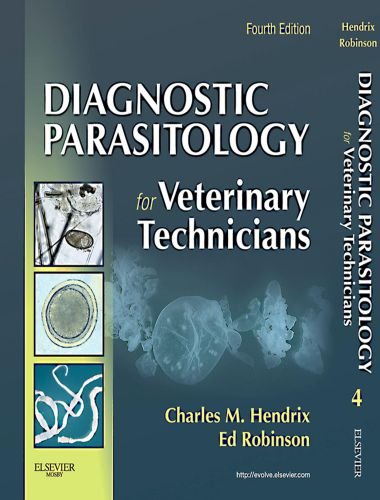Diagnostic Parasitology for Veterinary Technicians, 4th Edition By Charles M. Hendrix ,Ed Robinson August 2011, veterinary clinical parasitology is one of the most important disciplines in any veterinary curriculum, be it a curriculum training veterinary students or one that trains veterinary technicians.
Diagnostic Parasitology for Veterinary Technicians 4th Edition

This new edition was prepared to follow the educational structure used in parasitology classes in veterinary technology education. Our textbook is intended to inform the reader of the most commonly encountered internal and external parasites of both domesticated and laboratory animals.
The text begins with a chapter detailing the language of parasitology, the many terms that describe the intricate host-parasite relation-ships of veterinary parasitology. These terms are the “framework” of the discipline, the means of communication among veterinarians, veterinary technicians, and their clients. Every veterinary practitioner, veterinarian, veterinary technician, or student, must learn to effectively communicate in this language.
Each succeeding chapter describes a different parasite group: protozoans (one-cell organisms), trematodes (flukes), cestodes (tapeworms), nematodes (roundworms), acanthocephalans (thorny-headed worms), arthropods (insects, mites, and ticks), hirudineans (leeches), and pentastomes (tongue worms). As with the last edition, each of these parasite groups is described in detail, with special emphasis placed on morphology, uniqueness of the life cycle, and important parasites within the group.
The text begins with a new parasite table arranged by host species that provides key information on each parasite with page numbers for cross- reference throughout the book. Information on the parasites has been updated and new parasite information has been added to better prepare the technician for the parasites currently seen in the veterinary practice. A brief synopsis of each parasite is given before the in depth discussion.
This synopsis includes the parasite genus, species, host (including other hosts the parasite may affect), location of adult in host, distribution (where available), derivation of genus (many provided by Bowman: Georgis’ Parasitology for Veterinarians), transmission route and common name (where applicable). Treatments and preventive measures have been added to the sections on the major parasites seen in veterinary medicine.
A new chapter with a quick reference to the most common parasites has been added, containing pictures of the most common parasite ova seen in diagnostic tests. We have also made a major improvement with this edition with the replacement of black and white photographs with color photographs. We have endeavored to use as many color photographs as possible to assist in the demonstration of key morphologic and diagnostic features needed for proper identification of all classes of parasites. A glossary that defines the terms used in the text and an appendix that provides a quick reference to each parasite in the book, referenced by species, have been added.
Direct Link For Paid Membership: –
This Book is Available For Premium Members Only (Register Here)
Unlock 3000+ Veterinary eBooks or Go To Free Download
Direct Link For Free Membership: –
| Book Name: | Diagnostic Parasitology for Veterinary Technicians 4th Edition | |
| File Size: | 51 MB | |
| File Format: | ||
| Download Link: | Click Here | |
| Password: | PDFLibrary.Net (if Required) | |
